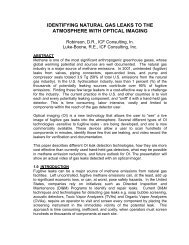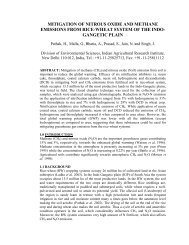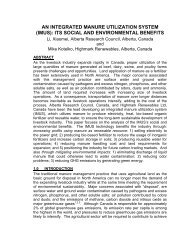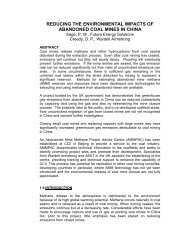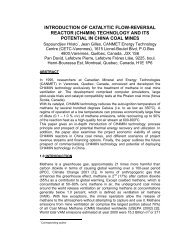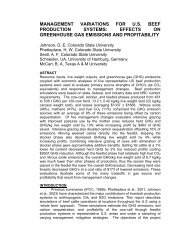Biogas Production From A Covered Lagoon Digester And Utilization ...
Biogas Production From A Covered Lagoon Digester And Utilization ...
Biogas Production From A Covered Lagoon Digester And Utilization ...
You also want an ePaper? Increase the reach of your titles
YUMPU automatically turns print PDFs into web optimized ePapers that Google loves.
During the initial 2-1/2 month testing phase, the microturbine was set to run as<br />
many hours per day as there was biogas available. In almost all instances, the<br />
reason for the microturbine shutting down was a “fuel fault” reading shown on the<br />
control panel. The situation that would trigger this readout was a drop in the Btu<br />
value of the biogas, due to possible air intrusion as the biogas was depleted from<br />
under the lagoon cover. This air intrusion would occur when the microturbine<br />
compressor was pulling biogas from under the cover at a slight negative pressure.<br />
It was also suspected that biogas was being lost from the same leak points that air<br />
intrusion occurred. <strong>Biogas</strong> leaking would occur when the microturbine was off, and<br />
a slight positive pressure under the cover would be forcing some of biogas out<br />
through the leak points. One of the suspected leak points was the soil under the<br />
area where the cover was attached to the lagoon bank. In order to correct this<br />
situation, a second plastic sheet was placed on the ground under the lagoon cover<br />
at the attachment area on the bank of the lagoon.<br />
Low microturbine production was experienced during the months of September and<br />
October 2002 because the covered lagoon liquid level was lowered by two feet<br />
during those months in anticipation of heavy rainfall in November and December<br />
that could exceed the runoff capacity of the overflow lagoon. When the level of the<br />
covered lagoon was lowered to this extent, it resulted in the outlet pipe’s being<br />
above the level of the lagoon. Therefore, since the lagoon level was below the<br />
outlet to the overflow lagoon, the only way to remove liquid from the covered lagoon<br />
was via the recycle pump which had its inlet in the exit area of the covered lagoon.<br />
Later in November, when the lagoon level was restored to its full capacity, the<br />
biogas production, and thus microturbine performance, increased, as shown in<br />
Table 2. Yet, even this increase was not as high as the production achieved during<br />
the initial testing in the summer months, and this was due in part to the lower<br />
lagoon temperatures in November and December (~15 o C) compared with July and<br />
August (~21 o C).<br />
One very interesting result of the microturbine testing was observed in December<br />
2002. On December 17 biogas utilization peaked at 100 cubic meters, as did net<br />
electrical output at almost 100 kwhrs. Because a very heavy rainfall occurred on<br />
the 17 th , and this resulted in significant water accumulation on the lagoon cover, it is<br />
speculated that this water pushed the lagoon cover down onto the water surface<br />
such that the biogas was forced to migrate to the Styrofoam cells and thus to the<br />
gas manifold at the lagoon bank.<br />
<strong>From</strong> the maximum observed in mid-December, biogas utilization and resulting<br />
electrical production began to fall, and in January 2003 the average hourly use was<br />
4.0 hours per day, at a setting of15kW. This resulted in an average biogas<br />
6



